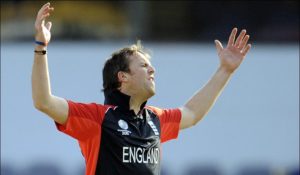We have heard about many Pre-performance routines which are effective in building confidence, managing anxiety and inducing mental readiness among athletes. Some athletes have a specific set of actions for their pre-shot routine or pre-kick routine. A synchronised set of physical activity, positive self-talk and technical rehearsal could be a part of the pre-game routine. Generally, athletes in endurance sports (like Rugby, Basketball, and Table tennis) may start off very well with the right mind-sets. However, one mistake can put them off and they might get stuck in the negative cycle of making continuous mistakes after that one bad shot or losing two consecutive points or missing a crucial pass.
Why do athletes go down-hill after their first mistake?
 The reason why athletes make more mistakes after their first one is because they are focused on that past mistake and their attentional capacity is divided into ‘the past mistake’ and ‘wanting to come back with a point or good pass’. Ideally, their attention should be on the present moment so that they can solve problems according to the current situation.
The reason why athletes make more mistakes after their first one is because they are focused on that past mistake and their attentional capacity is divided into ‘the past mistake’ and ‘wanting to come back with a point or good pass’. Ideally, their attention should be on the present moment so that they can solve problems according to the current situation.
Here is a link to the famous Williams VS Osaka US Open Finals match. If you watch Serena’s shots in the first round, you will notice that she has lost consecutive points. She kept losing points and got caught in that cycle to a point where it affected her mindset. Being able to recover from mistakes is important for athletes at every level. Even making minor mistakes can linger at the back of your head and you could lose focus on the present moment of the game.
https://www.youtube.com/watch?v=TTYFj-7-ksM
Difference between Pre-Performance and Post-mistake routines
Pre-Performance routines work as a set of anchors to induce a certain feeling. For example, an athlete who is feeling dull or under-aroused could be using self-talk which revolves around confidence and aggression. He or She could say ‘I am a champion, I am a winner, and I am the best’. An athlete who is over-aroused or anxious could use words like ‘I am calm, composed and focused on my game’. Both of these techniques are inducing a feeling of confidence.
Post-mistake routines are used to ‘shift’ the feeling or thoughts of the mistake to focus on the present. It often feels like a process of ‘getting rid’ of the upset feeling. Accepting mistakes and following a routine to forgive yourself and move on will enable athletes to shift their attention on the present without feeling like they need to ‘get rid’ of the feelings or thoughts.
Challenges with Post-mistake routines
- Dealing with feelings
Athletes might often feel like they are being told to ‘not feel bad’ about their mistakes. It is alright to feel bad and upset but it is more important to focus on the game and coaches can address this in training when an athlete is overreacting after making a mistake. A simple technical instruction to focus on the ‘process’ will direct the athlete’s attention from the ‘outcome’ back onto the process
- Negative Body Language
 Athletes often show their mistakes through their body language. These gestures strengthen the pattern of the negative mindset and often get the athletes stuck in a cycle. Body language and gestures act as cues for our mind to interpret emotions as a result of long-term associations between emotion and gestures. For example, if you bow your head down and walk, you will automatically feel dull. Coaches and teammates can remind each other to change their body language after making a mistake. This will weaken the pattern of reaction after mistakes and reduce the likelihood of the negative cycle.
Athletes often show their mistakes through their body language. These gestures strengthen the pattern of the negative mindset and often get the athletes stuck in a cycle. Body language and gestures act as cues for our mind to interpret emotions as a result of long-term associations between emotion and gestures. For example, if you bow your head down and walk, you will automatically feel dull. Coaches and teammates can remind each other to change their body language after making a mistake. This will weaken the pattern of reaction after mistakes and reduce the likelihood of the negative cycle.
- Cognitive resources
Overthinking can be another challenge in dealing with mistakes. Athletes should shift their focus to the ‘now’ instead of over analysing and planning too much for a comeback. I often ask my athletes to use what, why and how questions when they are overwhelmed after making a mistake. What is in my control NOW? Why is it important? How will I achieve it?
Sometimes, making yourself aware of a situation and giving yourself that ‘reality check’ after a mistake can make it easier to shift your focus.
Most effective post -mistake routines
Learning is a complex process involving awareness, instinct, problem-solving and execution. A post-mistake routine should be practised in training and competition. The time you take to recover from mistakes and the rate of recovery will improve with practice.
A powerful routine should have components to deal with thought, emotion and behaviour. It should allow you to focus your thoughts on the ‘Now’, settle any negative body sensations or feelings and make you feel mentally and physically ready for the rest of the math after making a mistake. A post-mistake routine can be as short as 5 seconds or as long as a minute depending on the sport and the time an athlete can spare in the game. It is important to realistically plan your post-mistake routine and use trial and error in training to see what works well for you. A combination of the strategies suggested below can be used to develop a post-mistake routine.
Breathing
Observing your own breath often makes you aware of your feelings and thoughts. Taking 10 seconds to focus on your breath after a mistake will give an athlete a bit of time to self-soothe. Diaphragmatic breathing can be used if an athlete has more time. This can also be a part of a team ritual during half-times.
Self-Talk
Instructional and positive self-talk can boost an athlete’s confidence and shift their attentional focus from ‘outcome’ to ‘processes’. Every athlete should analyse what they think about in their training and competition after a mistake and how those thoughts make them feel. Small phrases, quotes, “I” Sentences can all be a part of the routine and be combined with an action (a trigger). For example, you can tap your own shoulder and say “you can do this”.
Triggers can be external or internal. It can be a body movement, a thing or words. Triggers generally work as a ‘switch on’ button. Athletes need to associate a certain feeling to a specific trigger. For example, an athlete could practise a specific stretch after making a mistake- A stretch that makes him or her feel confident. Athletes can also use their sports equipment as a trigger- for example, gloves in cricket or football during a match. Words such as ‘move on’ ‘switch on’ ‘Stay focused’ can also be used as triggers after a mistake is made.
In conclusion, Post-mistake routines should be thought through. You will need to practise and alter your routine from time to time. You can also have different routines for different types of roles or situations in a game.
Here is a link to look at some successful pre-performance routines
Please feel free to leave your comments and views! For further discussions on the topic, please contact me at sarah@sarahmajid.com
Please note that this blog is based on the writer’s interpretations of research, applied knowledge and experience working as a Trainee Sports and Exercise Psychologist.
Sarah Majid
Trainee Sports and Exercise Psychologist
Bristol Academy of Sports
